Adding a new pet to the family is so exciting! However, if you have another pet at home already, it can change up the household dynamic. It’s important to handle the first introductions between your two pets carefully, in order to set them up for a lifelong friendship. The early interactions they have will set the tone for their long term relationship.
Below is a guide on introducing a new pet to an existing family pet - with the right approach and plenty of patience, they may develop into great buddies.
Below is a guide on introducing a new pet to an existing family pet - with the right approach and plenty of patience, they may develop into great buddies.
If you want to skip to the section relevant to your fur family’s needs click the link below:
Introducing a new puppy to a family dog
Introducing a new dog to the family cat
Introducing a new cat to your family dog
Introducing a new puppy to a family dog
Understand your existing dog’s behaviour
Hopefully if you’re adding a new pup to the family, it means your existing dog is sociable with other dogs! If not, this is an issue you’ll want to address before bringing your pup home, so look into some training you can do or consult a behaviourist (feel free to message me directly if you need some advice!)
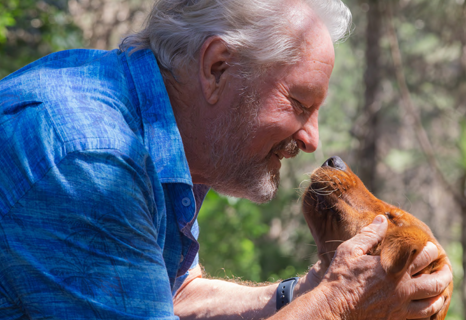
Mark Vette is a world-renowned Animal Behaviourist, Zoologist and Trainer. He brings together a unique combination of academic studies with 40 years of applied clinical animal behaviour consulting and treatment. Mark is a member of the International Association of Animal Behaviour Consultants. This article was written by Mark and the views expressed are his own.
Gradually introduce scents
If it’s an option, exchange scents between the two dogs before the first meeting. You could bring home an item from the pup’s whelping den before the pup comes home, or on the day you can even just rub a cloth on each dog and let the other sniff it before the meet and greet. This helps them become familiar with each other’s scent in a non-threatening way.
Get your older dog calm before introducing the pup
Use high value treats (and ideally a clicker if you’re familiar with clicker training) to run through some simple commands with your dog before you bring your pup in. This helps get them calm and focused on you, and in a better state for meeting someone new.
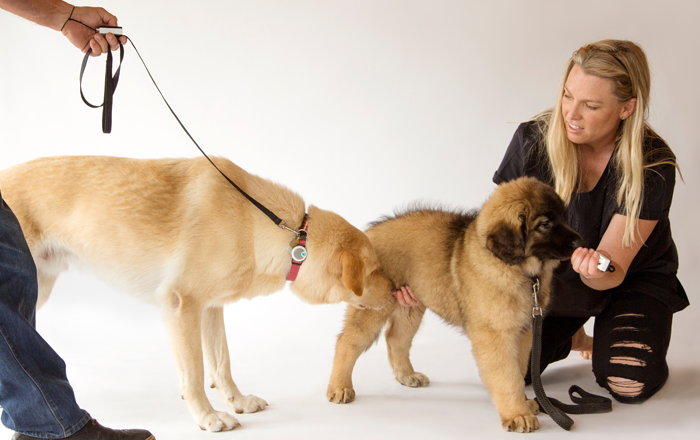
Start with a neutral meeting spot
If your current dog is territorial with other dogs, arrange the first meeting in a neutral location, such as a park or a neighbour’s yard, If not, at home is fine but have two people involved.
Bring your pup in
Bring pup in either carried in your arms or on a lead and have your other dog on a lead too. Present the pup's rear-end to your older dog first and let your older dog have a really good sniff of this area. Reward your older dog with a treat once they have finished sniffing here, but don’t interrupt the sniff – they are getting important information about the new pup!
These pheromones will help appease your older dog from the get-go and set them up for a positive interaction.
Once this is done, allow your pup down to sniff your older dog. Keep pup on a lead or under good control so you can prevent pup from jumping up all over your older dog too much if necessary. Let them have a good sniff and interaction with each other, rewarding both dog and pup throughout. Don’t allow any aggression of course.
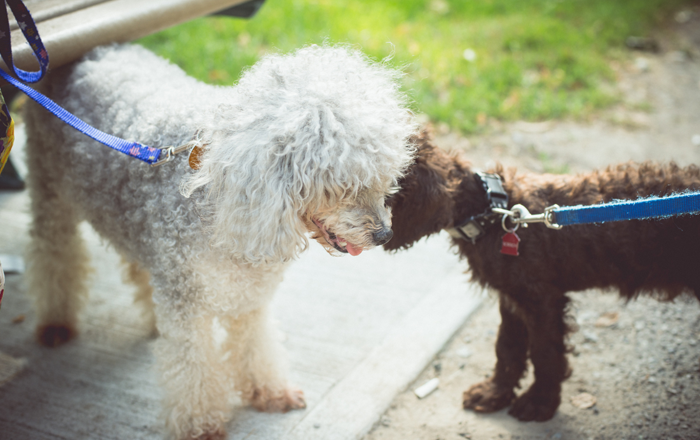
Keep the initial interaction short
The first couple of meetings should be brief and positive, we don’t want to overdo it on the first day! If both dogs are highly sociable and things are going well, you can give them a bit longer to have some play time, but wrap it up while things are still on a positive note and pop your pup away for a rest.
Moderate your pup
Supervise interactions for the first couple of weeks. Puppies can be energetic and may irritate older dogs, so intervene if your older dog shows signs of annoyance and pop pup away for some rest in their crate. It’s normal for older dogs to give pups a bit of a growl or snap as a warning if they’re being too over-the-top, but we don’t want to trigger a truly aggressive response or for the pup to get injured.
Manage playtime
If your older dog is big or boisterous, their play may be too rough for your delicate young pup’s joints. Manage play sessions carefully to ensure it’s not too rough and your pup isn’t at risk of injury, and keep play sessions to 10-20 minutes at a time to begin with.
Provide time out
Protect their relationship by giving your older dog plenty of space from the pup each day, so they’re not constantly having to cope with that full on new puppy energy! Provide your older dog access to areas in the home that are out of bounds to your pup, or give your pup plenty of crate time - they need 16-20 hours rest a day until 6 months old anyway!
Lots of positive reinforcement
Provide TONNES of positive reinforcement to both dogs for any calm, relaxed, sociable behaviour around each other - I favour using a clicker and treats for this, but pats and praise are great too.

Introducing a new dog to the family cat
Preparing your cat
It’s helpful if your cat is already comfortable with spending time in a crate before introducing them to your new dog. This allows you to manage the first meeting in a controlled environment.
If time permits, work on desensitising your cat to the crate before the dog’s arrival. You can do this by feeding your cat inside the crate, offering high-value treats there, and allowing them short, positive experiences throughout the day so they associate the crate with comfort and safety.
Setting up your home
Create distinct areas for your cat and your new dog to ensure everyone feels secure. Your cat needs a safe space they can retreat to, away from the dog. This can prevent your cat from avoiding the house or feeling overwhelmed by the dog’s presence. Baby gates are an effective way to separate spaces, or you could provide an open window leading to a dog-free area of the house.
Understanding your dog
If you’re bringing home a puppy, this is a fantastic opportunity to teach them from the start to co-exist peacefully with your cat. For older dogs, check with the breeder or rescue for any information about their behaviour around cats. If there’s a history of aggression or high prey drive, seek professional advice before proceeding with introductions, or don’t choose that dog.
Scent swapping
Before their first meeting, exchange bedding or toys between your cat and dog. This allows both to become familiar with each other’s scent, laying the groundwork for a smoother introduction.
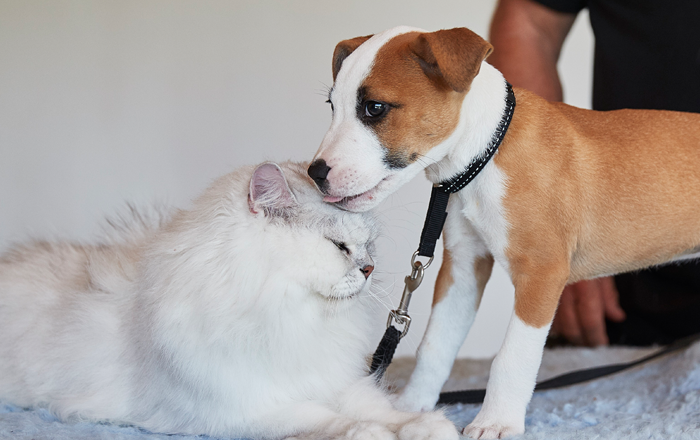
Controlling the stimulation
It’s crucial to introduce your dog to the cat in a way that minimises excitement or overstimulation. If your cat bolts at the first meeting, it could trigger your dog’s instinct to chase—something you want to avoid. Start the introductions slowly, keeping both animals calm and relaxed.
Here’s a suggested progression (with dog on lead always):
- Cat in a crate
- Cat out of the crate but stationary, such as in someone’s arms or confined to the same room
- Cat moving freely but with safety measures in place.
The first meeting
For the initial interaction, keep your dog on a lead and your cat safely in a crate. Cover part of the crate with a sheet to give your cat a secure spot to retreat if needed.
Before bringing your dog into the room, spend a few minutes helping them relax by practising basic commands like Sit or Down and rewarding them with treats. This sets a calm tone for the introduction. Walk the dog up to the crate and let them investigate while rewarding calm, non-aggressive behaviour with high-value treats or a clicker.
Repeat this setup for the first few interactions, ensuring both animals remain calm and safe. Assess the situation from the first meet and greet as to how quickly you can proceed.
Moving to the next stage
Once both animals are comfortable, let your cat out of the crate but keep them in a controlled environment, such as being held or confined to a room with your dog still on a lead. Give your cat access to elevated spaces where they can observe the dog from a safe vantage point, and ideally block access to low hard to reach areas, like under the couch.
Continue rewarding your dog for calm behaviour. As your cat begins moving around, stay vigilant as this may excite your dog. Use treats and commands to maintain their focus on you and to help them stay relaxed.
Testing off-lead interactions
When your dog has demonstrated consistent calmness and sociability, try letting them drag the lead in the same room as your cat. Always ensure your cat has access to vertical escape routes and keep rewarding your dog for appropriate behaviour. If going well, take lead off altogether.
When to seek professional support
Some dogs have strong prey drives or may struggle to remain calm around cats. Puppies might view cats as playmates, leading to unwanted chasing, while older dogs may lack prior socialisation with felines. If your dog shows signs of aggression, such as barking, growling, or lunging, consider consulting a us or another professional to guide the process.
Introducing a new cat to your family dog
Preparing your dog
Before welcoming a new cat into your home, it’s crucial to assess how your dog is likely to react. Ideally, your dog has already had positive experiences with cats and does not display any chasing or predatory behaviours. If your dog does show signs of aggression toward cats, it may be worth reconsidering the addition of a cat or consulting a professional behaviourist to address the issue before proceeding.
In the weeks leading up to bringing your new cat home, try exposing your dog to confident, friendly felines in controlled environments (e.g. visiting friend’s homes with a cat, not just out and about). Reward calm, non-aggressive, or disinterested behaviour with treats to reinforce positive associations, ideally clicker train your dog to assure it going better.
Timing the introduction
It’s a good idea to give your new cat or kitten a few days to settle into their new environment before they meet your dog. Set up a small, secure area for your cat—such as a bathroom or laundry room—where they can establish their own safe space. Include essentials like a bed, food and water bowls, toys, and a litterbox. Allow them to adjust to their surroundings for at least 2–3 days before beginning introductions, which can typically happen around day three or four.
Helping your dog get used to your cat’s scent
During your cat’s initial adjustment period, introduce your dog to their scent by letting them sniff items your cat has used, like a blanket or towel, or by swapping toys between them. This helps your dog become familiar with your cat’s presence before their first face-to-face meeting. Your dog will likely pick up on the cat’s scent throughout the house as well, reinforcing the idea of a new addition. Feed them on each side of the adjoining door for that period. You want the cat to establish itself in the cat room so it has a safe place to retreat to.
Controlled introduction
When it’s time for the first introduction, use a physical barrier to ensure both pets can see and smell each other without direct contact. This could involve placing your cat in a crate or using a baby gate at the doorway to their safe room. Keep the dog on a lead initially and use a clicker and reward your dog with treats and praise for calm and polite behaviour during these initial interactions.
Supervised meetings
Once the barrier interactions are going well, allow your dog and cat to meet under close supervision. Keep your dog on a lead to maintain control and prevent any sudden movements—especially if your cat is a small kitten, as they’re particularly vulnerable. Reward your dog for calm and friendly responses, and step in if your dog barks, growls, lunges, or attempts to chase.
Make sure your cat has access to high perches or escape routes during these interactions. Elevated spaces help them feel secure and allow them to observe your dog from a safe vantage point. Supervise all interactions closely for at least a couple of weeks, until you feel confident in their ability to coexist.
Take great care when moving outside, as if the cat runs the dog is more likely to chase and everything can go sour from there. Do not allow any chasing, even if it’s in apparent play.
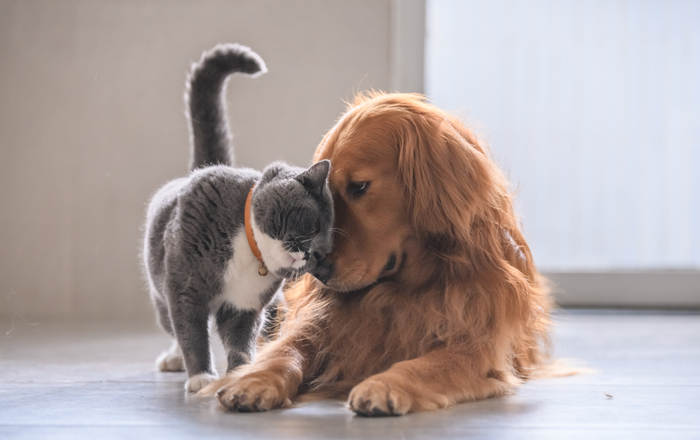
Encouraging calm behaviour
Whenever your pets are in each other’s presence, reward them for staying calm and relaxed. This reinforces positive associations and helps build trust over time. Avoid rushing the process or forcing interactions; let them adjust at their own pace.
When to seek professional help
It’s normal for some tension to arise in the beginning, but with patience and consistent effort, most cats and dogs can learn to live together peacefully. However, if your dog exhibits aggression or predatory behaviour, it’s best to consult us or another professional behaviourist for guidance.
All the best with your new companion!
I hope this advice helps you build a lasting friendship between the special creatures in your life.
Always consult your vet on the best way to look after your pet. And to avoid unexpected costs, make sure your pet is insured.
Have a look at our pet insurance plans to choose the right insurance plan for your pet.
